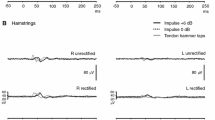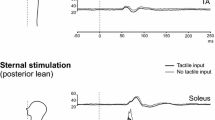Abstract
Impulsive stimuli were used to evoke postural reflexes in healthy subjects (n = 10) and avestibular patients (n = 2). Electromyographic (EMG) activity was recorded with subjects standing erect, feet together with eyes closed and leaning forward to activate their leg muscles. EMG was recorded bilaterally from over the soleus muscles, rectified and averaged. The evoked response was biphasic and consisted of a short latency (SL) and a smaller medium latency (ML) response, at approximately 60 and 80 ms post-stimulus, respectively. Reflex amplitude was expressed as a percentage of the prestimulus level. Stimulus rise times of 10 and 14 ms evoked the largest responses. SL responses were largest when stimulating at the vertebra prominens (C7) or over the mid-thoracic region (C7: 56 ± 42 %, mid-thoracic: 56 ± 51 %). Positive (push) stimuli evoked larger responses than negative stimuli which evoked an initial inhibition (C7 positive: 56 ± 42 %, C7 negative: −12 ± 5 %). Similarly, increasing intensity also produced larger responses (standard intensity: 56 ± 42 %; increased intensity: 80 ± 53 %). There was no apparent EMG response in the sitting condition, despite activation of calf muscles, indicating the reflex was dependent on posture. Avestibular patients had well-formed responses similar to normals (patients: SL = 137.5 and 84.5 %, ML = −11.6 and −16.2 %) with mildly prolonged latencies. This study has described the basic properties of a reflex evoked by impulsive accelerations of the trunk that we propose is not primarily dependent upon vestibular afferents and is likely to have a role in normal postural stability. A truncal origin of the receptors mediating the response best fits our observations and is an alternative explanation for some previous reports about postural reflexes in response to limb displacements.







Similar content being viewed by others
References
Allum JHJ, Honegger F, Acuña H (1995) Differential control of leg and trunk muscle activity by vestibulo-spinal and proprioceptive signals during human balance corrections. Acta Otolaryngol 15(2):124–129
Angelaki DE (2004) Eyes on target: what neurons must do for the vestibuloocular reflex during linear motion. J Neurophysiol 92:20–35
Bloem BR, Allum JHJ, Carpenter MG, Honegger F (2000) Is lower leg proprioception essential for triggering human automatic postural responses? Exp Brain Res 130:375–391
Bloem B, Alum JHJ, Carpenter M, Verschuuren J, Honegger F (2002) Triggering of balance corrections and compensatory strategies in a patient with total leg proprioceptive loss. Exp Brain Res 142:91–107
Bötzel K, Feise P, Kolev O, Krafczyk S, Brandt T (2001) Postural reflexes evoked by tap** forehead and chest. Exp Brain Res 138:446–451
Bötzel K, Kolev OI, Brandt T (2006) Comparison of tap-evoked and tone-evoked postural reflexes in humans. Gait Posture 23:324–330
Britton TC, Day BL, Brown P, Rothwell JC, Thompson PD, Marsden CD (1993) Postural electromyographic responses in the arm and leg following galvanic vestibular stimulation in man. Exp Brain Res 94:143–151
Fitzpatrick R, McCloskey DI (1994) Proprioceptive, visual and vestibular thresholds for the perception of sway during standing in humans. J Physiol 478:173–186
Forssberg H, Hirschfeld H (1994) Postural adjustments in sitting humans following external perturbations: muscle activity and kinematics. Exp Brain Res 97:515–527
Gurfinkel VS, Lipshits MI, Mori S, Popov KE (1981) Stabilization of body position as the main task of postural regulation. Hum Physiol 7:155–165
Halmagyi GM, Yavor RA, Colebatch JG (1995) Tap** the head activates the vestibular system: a new use for the clinical reflex hammer. Neurology 45:1927–1929
Honeycutt CF, Nardelli P, Cope TC, Nichols TR (2012) Muscle spindle responses to horizontal support surface perturbation in the anesthetized cat: insights into the role of autogenic feedback in whole body postural control. J Neurophysiol 108:1253–1261
Horak FB, Shupert CL, Dietz V, Horstmann G (1994) Vestibular and somatosensory contributions to responses to head and body displacements in stance. Exp Brain Res 100:93–106
Laube R, Govender S, Colebatch JG (2012) Vestibular-dependent spinal reflexes evoked by brief lateral accelerations of the heads of standing subjects. J Appl Physiol 112:1906–1914
Marsden CD, Merton PA, Morton HB (1981) Human postural responses. Brain 104:513–534
Nashner LM, Wolfson P (1974) Influence of head position and proprioceptive cues on short latency postural reflexes evoked by galvanic stimulation of the human labyrinth. Brain Res 67:255–268
Rosengren SM, Welgampola MS, Colebatch JG (2010) Vestibular evoked myogenic potentials: past present and future. Clin Neurophysiol 121:636–651
Rothwell JC (1994) Control of human voluntary movement, 2nd edn. Chapman & Hall, London
Sattin RW, Lambert Huber DA, DeVito CA, Rodriguez JG, Ros A, Bacchelli S, Stevens JA, Waxweiler RJ (1990) The incidence of fall injury events among the elderly in a defined population. Am J Epidemiol 131:1028–1037
Todd NP, Rosengren SM, Colebatch JG (2008) Ocular vestibular evoked myogenic potentials (OVEMPs) produced by impulsive transmastoid accelerations. Clin Neurophysiol 119:1638–1651
Traub MM, Rothwell JC, Marsden CD (1980) Anticipatory postural reflexes in Parkinson’s disease and other akinetic-rigid syndromes and in cerebellar ataxia. Brain 103:393–412
Welgampola MS, Colebatch JG (2001) Vestibulospinal reflexes: quantitative effects of sensory feedback and postural task. Exp Brain Res 139:345–353
Acknowledgments
We thank Prof. GM Halmagyi for referring patients included in this report. This work was supported by the Garnett Passe and Rodney Williams Memorial Foundation and the National Health and Medical Research Council of Australia.
Author information
Authors and Affiliations
Corresponding author
Rights and permissions
About this article
Cite this article
Graus, S., Govender, S. & Colebatch, J.G. A postural reflex evoked by brief axial accelerations. Exp Brain Res 228, 73–85 (2013). https://doi.org/10.1007/s00221-013-3539-8
Received:
Accepted:
Published:
Issue Date:
DOI: https://doi.org/10.1007/s00221-013-3539-8




